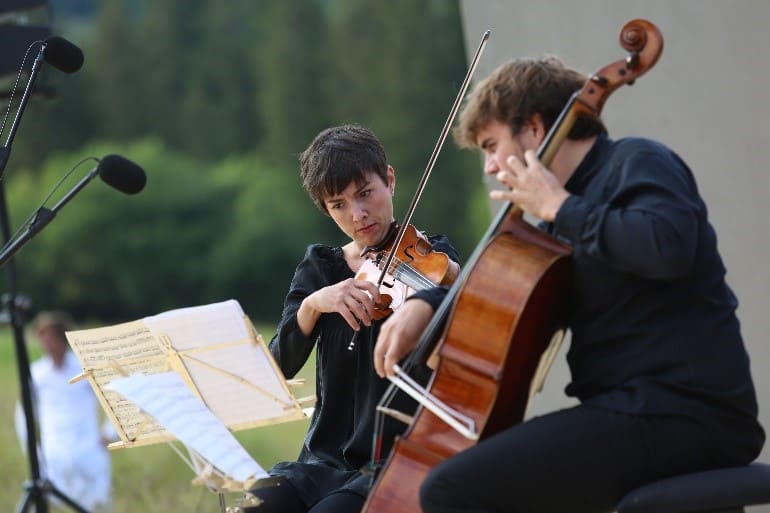A Uniline Compact system deployed at 5,000 feet proved a hit with both artists and festivalgoers as the intimate classical music event returned.

Like nearly all festivals in Europe, Musique à Beauregard – which has taken place on a protected natural site in the Alpine foothills, in eastern France, since 2017 – was forced to postpone its 2020 edition because of restrictions on large events. For its comeback the festival more than made up for lost time, boasting a diverse, crowd-pleasing music line-up, a brand-new stage, and a state-of-the-art audio setup designed to complement the natural acoustic support provided by the Aravis mountain range.
Measuring 15m x 10m , the new stage provided an ideal proving ground for the festival’s new sound system, comprising several speakers from APG’s light, flexible Uniline Compact range.
In addition to providing the festival’s more than 3,500 guests with an even, natural listening experience at an altitude of 1,500m, the system’s light weight and portability allowed for easy transport to the four festival locations: the open air at the Plateau de Beauregard, La Clusaz church, La Clusaz cinema and the Espace Grand-Bo in Le Grand-Bornand.
Sound engineer Léopold Randon de Grolier says the APG system, consisting of two UC206 N speakers and one UC115B per side and powered by two DA 15:4 DSP amplifiers, proved to be the perfect match for the festival’s eclectic live programme, which included classical music, dance and spoken-word performances – and where the natural reproduction of sound was paramount.
“APG's Uniline Compact line-array loudspeakers provide a natural, unaltered sound and are respectful of the timbre and dynamics of the instruments,” explains Randon de Grolier, who with his Radio Semnoz colleague Hervé Dufournet heads up sound reinforcement for Musique à Beauregard. “People feel like they are directly hearing the instruments. Thanks to these technical and sonic characteristics, this system has been a major ally for us for several years on various classical and jazz music performances.”
The APG sound system is complemented by a complete sound pick-up solution with a set of microphones (DPA, Schoeps, Neumann, Griffon Microphones, AKG) and a Yamaha system consisting of a TIO-1608-D stagebox and TF3 console (via Dante).
One of the key metrics of success for the new system was its ability to deliver consistent sound across four very different festival venues. While APG’s software did some of the hard work for the sound engineers, they still needed hardware that would rise to the challenge of adapting to “different uses and locations: open-air concerts, concert halls, cinemas and highly reverberant churches,” continues Randon de Grolier. “Intelligibility is a very important criteria, and the waveguide technology developed by APG, combined with the quality of the loudspeakers, allowed us to work serenely in different configurations.”
On the new outdoor stage, he adds, the system delivered “even coverage for the entire audience, who were spread over several tiers facing the majestic Mont Blanc, thanks to its excellent directivity.”
This versatility is one of the key selling points for the Uniline Compact range, whose nearly unlimited range of applications – indoors and outdoors, short and long throw, rental/staging and fixed installation – make it the perfect solution for businesses in need of a flexible system that can handle everything they throw at it.
As the Radio Semnoz team put the Uniline Compact boxes through their paces, both the audience and the performing artists enjoyed the natural, high-quality sound reproduction offered by the discreet APG system, says Randon de Grolier.
“Feedback on the quality of the sound was unanimous, and the artists particularly appreciated the sound reinforcement provided by the APG system,” he concludes.
“An important element for classical musicians was the discretion of the system, both visually and sonically, as they are not used to being amplified. My job as a sound engineer is to optimise the system so that it ‘disappears’ and the sound can be heard. Indeed, they were able to hear the sounds of their instruments without them being altered either by the recording system or by the playback system.”

Photo credit: Office du Tourisme de La Clusaz / Yannick Perrin


